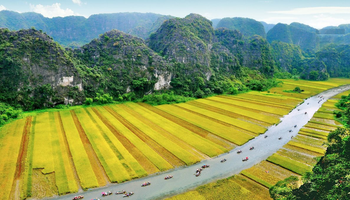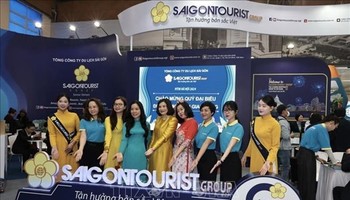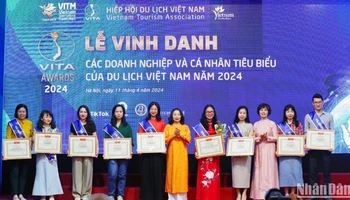Accordingly, the values of culture, lifestyle and cuisine of the local communities have been utilised. The locals themselves have implemented these models and benefited from them. However, in order to develop community-based tourism, Hanoi City’s authorities should enhance methodical investment, especially in technical and tourism infrastructure.
Helping local people improve skills in developing tourism
Just a few days after Hanoi removed social distancing orders, the municipal Department of Tourism, in collaboration with the Thuong Tin District People’s Committee, held a training course on civilised behaviour in tourism activities.
Ha Thai is a lacquer village near Hanoi specialising in producing souvenirs . With techniques of making handicrafts with traditional materials, the local artisans have created thousands of products such as bowls, plates, flower pots, trays, paintings and mosaics to meet the tastes and demands of both domestic and foreign customers. Previously, the main materials were wood covered with paint; however, there are now many other products made of bamboo, rattan and ceramics. Ha Thai Village’s products are compact and affordable, so they are very popular. Deputy Secretary of the Duyen Thai Communal Party Committee Ngo Dinh Tien still pondered: “Ha Thai is located near the centre of the capital and has favourable transportation conditions and traditional craft. However, the villagers have only focused on making products for export but haven’t payed attention to tourism development. In addition, they still lack communication and foreign language skills to interact with international visitors”.
Community-based tourism is a model focusing on utilising the cultural values, lifestyle and cuisine of a community. This trend has developed strongly in the world as tourists’ demand for experiencing cultural activities has increased. For this tourism form, people play a central role in guiding guests to experience the culture, lifestyles and cuisine as well as providing the tourists with other services. In Hanoi, the old quarter, the trade villages, ancient villages and relic sites that are located within the community are the areas with great potential for developing community-based tourism.
The Covid-19 pandemic has changed the consumption demand of tourists. They tend to search for destinations to discover by themselves instead of joining crowded tours. This is a good opportunity for the development of community tourism. Nguyen Minh Hanh, an official from the Hanoi Municipal Department of Tourism said: “Hanoi always focuses on cultural and trade village tourism forms. The human resources directly involved in community tourism activities are local people who are important links to determine the quality and the development of the community-based tourism form. Over recent years, the department has coordinated with the localities to organise training courses on necessary skills for the locals in the potential destinations, trade villages and ancient villages in Co Loa Commune (Dong Anh District), Huong Son Commune (My Duc District), Cuu Village (Phu Xuyen District) and Lai Xa Village (Hoai Duc District)”.
Thanks to support from the municipal Department of Tourism and the local authorities, many attracted community-based tourism models have been formed with synchronous products, especially Bat Trang Pottery Village, Duong Lam Ancient Village and Dao Thuc Water Puppetry Village. Visitors to these destinations can visit and experience cultural activities, enjoy the local specialties and buy souvenirs imbued with local identities. They even can stay at homestays. Most of the services are provided by the local people. For example, the catering services in Bat Trang Village were mostly spontaneous in the past; however, there are now many restaurants serving typical foods. Duong Lam Ancient Village has now over 100 households that have joined the “supply chain” of tourism services, which has brought about stable income for them. Nguyen Thu Thuy from Thanh Xuan District, Hanoi, a visitor to Bat Trang Pottery Village, said: “When I visited the ancient pottery kiln area that has been preserved for hundreds of years, the hosts welcomed me and introduced it both professionally and enthusiastically. They were also very happy although I only visited and did not taking part in paid services.”.
Methodical investment
The community-based models have been formed mainly on the outskirts of the capital, bringing about practical effects. However, they are still facing limitations in their development. Bat Trang pottery has been popular both in the country and abroad for around 1,000 years with many beautiful and applicable designs. However, the village has only welcomed around 200,000 guests per year.
In addition, Duong Lam Ancient Village is a “museum” rural life in the northern Vietnam. According to deputy head of the village’s management board, Nguyen Trong An, it received around 150,000 guests in 2019. The figure was not adequate given its potential. The numbers of visitors to other destinations, such as Dao Thuc Water Puppetry Village, Cuu Village and Hong Van Ornamental Creature Village, are also not high.
In fact, Hanoi has just only focused on instructing local people with the tourism skills, developed services and souvenirs, and invested infrastructure for several tourist attractions, trade and ancient villages with high potential for the development of community-based tourism. Therefore, other ancient and trade villages still face difficulties in both basic and tourism infrastructure. In addition, the planning and implementation of the plans for potential trade and ancient villages has been slow. For example, the development plans for Bat Trang Pottery Village and Van Phuc Silk Village have been launched in 2016 but they have not yet been completed.
Trinh Xuan Tung, an official from the Hanoi Municipal Department of Tourism, said: “In order to exploit the tourism potential, the localities should pay more attention to environmental landscapes and installing signs for visitors. In addition, it is crucial to develop specific plans and form functional areas to welcome and serve visitors. In particular, the localities should coordinate with travel enterprises in attracting and serving tourists”.
In 2013, the Hanoi Municipal People's Council issued the Resolution No.25/2013/NQ-HDND on the policies to encourage the development of specialised and concentrated agricultural production areas and trade villages; as well as to invest in clean water supply in rural areas and the city. Accordingly, the regulations on the support for tourism infrastructure have been outlined. The organisations and individuals will receive the aid from State budget to purchase materials for construction of car parks, public toilets, and display areas for products. The support will not exceed VND1 million per trade village. The Department of Agriculture and Rural Development has asked the municipal People’s Committee to consider the increase of the support for the investment in tourism infrastructure in the trade villages in the near future.
















